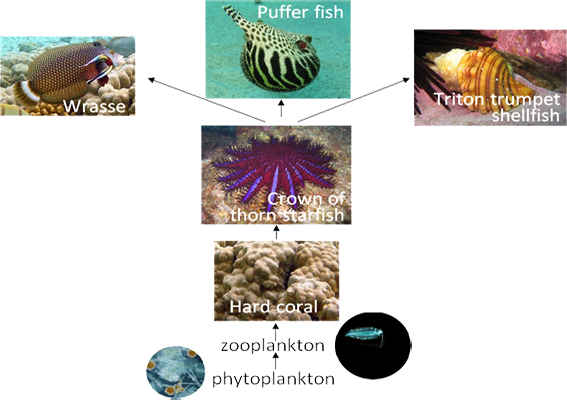Crown of Thorns starfish I
0
Overview
Using this Resource
Connecting to the Curriculum
Marking Student Responses
Working with Students
Further Resources
This task is about what diagrams of food chains can and/or cannot tell you about the organisms involved.
Scientists have observed the Crown of Thorns starfish eating hard coral and being eaten by fish such as wrasse, puffer fish and the triton trumpet shell fish.
They represent this feeding relationship in food chains as shown below.

Task administration:
This task can be completed with pencil and paper or online.
Level:
5
Curriculum info:
Keywords:
Description of task:
Task: Decide what information can or cannot be inferred from food chain diagrams. Assessment focus: reading food chains
Curriculum Links:
Science capabilities
The capabilities focus is brought about by the conversations you have and the questions you ask.
Capability: Use evidence
This resource provides opportunities to discuss what/how much evidence is needed to support an explanation.
Capability: Interpret representations
This resource provides opportunities to discuss scientific conventions for representing feeding relationships (a food web).
Science capabilities:
Answers/responses:
|
Questions
Choose which idea is being represented by the direction of the arrows.
|
Responses
|
| Choose which 2 things the Crown of Thorns food chain tells us about the hard coral. |
|
| Choose which 2 things the Crown of Thorns food chain does not tell us about the Crown of Thorns predators. |
|
|
From the information in the Crown of Thorns food chain, for each of the following three statements choose whether you think scientists could confidently predict an outcome without gathering further information.
|
Accept any answer for each of the statements. Evidence should support student's choice.
Students might look at the short term:
one change e.g.,
Students might look at the long term:
more than one change e.g.,
Or changes that eventually restore the system to a balance/equilibrium, e.g.,
Students that answer it depends might ask questions, e.g.,
|
Diagnostic and formative information:
| Questions | Problems/Misconceptions |
| Choose which idea is being represented by the direction of the arrows. |
Most students who answered incorrectly chose:
The nutrients the predators obtained
Next steps:
Discuss that the arrows go that way because scientists wanted to show the direction of energy transfer and this was the convention they agreed on.
|
|
From the information in the Crown of Thorns food chain, for each of the following three statements choose whether you think scientists could confidently predict an outcome without gathering further information.
|
Most of the students answered that they could confidently predict an outcome without gathering further information. These students were focused on the immediate effect of removing a predator or increasing the food supply e.g.,
With no predators, the hard coral can live longer and produce more coral babies and increase the population.
Because zooplankton feed off phytoplankton so if there is more phytoplankton there will be more zooplankton becasue there is more food.
Others gave more connections. They were beginning to show long term effects and how all the organisms in a system are affected by a change, e.g.,
The more COT starfish there are, the less hard coral resulting in more zooplankton and thus less phytoplankton.
more COT means more food for predators meaning back to equilibrium.
|
Based on a sample of 38 students completing the task on-line.
Next steps:
Science Capability: Interpret representations
Scientists use representations to tell us about an idea, an object, a process or a system. They are often 'limited' representations of the particular idea or 'thing' that is being talked about. A food chain diagram is a limited representation of an organism's feeding relationship.
To understand the limitation of representations teachers could ask students to consider what the food chains or food webs tell us and what is left out. As in the Cockles resource they could also:
- research one of the organisms in a food web and list all the things they eat; and/or
- include another of their food sources into the food web with the connections to other organisms in the food web that also eat this food.
The following Level 5 ARB resources are about food chains:

